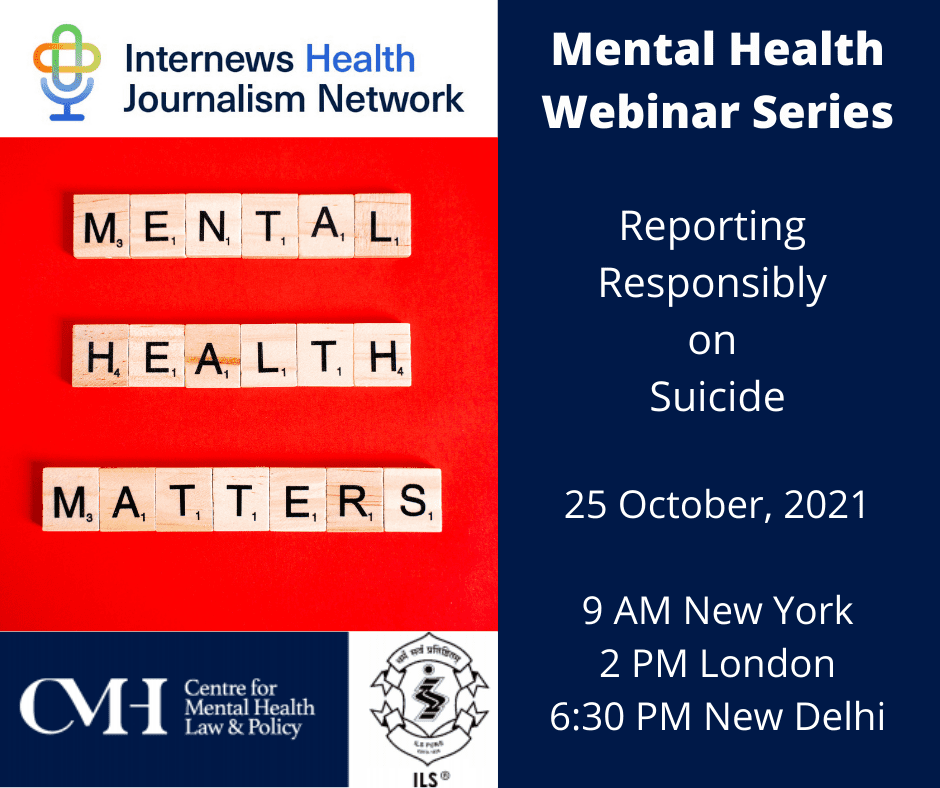Compiled by Kathryn Cleary
The evidence is in! Responsible media reporting can reduce suicides by up to 2 percent. With more than 700,000 people choosing to take their own lives each year, this means that responsible reporting can save over 14,000 lives.
For every suicide, there are several people who attempt it. Suicide is a growing risk in the wake of loss and stress caused by the COVID-19 pandemic and in this context, the Internews Health journalism Network in partnership with the Centre for Mental Health Law and Policy (CMHLP) hosted a discussion on how journalists can responsibly report on suicide. The discussion featured expert insights from the CMHLP as well as two journalists who shared their personal experiences with suicide, plus a demonstration of a free e-learning course for journalists.
This is the first webinar in a two-part series on mental health. Keep checking our website and social media accounts for details about the next session which is scheduled preliminarily for the third week of November.

Kicking off this session was Dr Soumitra Pathare, Director of the CMHLP, speaking on how suicide is increasingly understood as a public health issues. An expert insight into why suicide is increasingly understood as a public health issue
How do we view suicide as a public health issue? How do journalists research this or find new angles for reporting?
“Close to 800,000 people every year across the world die of suicide,” says Pathare, in low and middle income countries suicides tend to be an issue for young people. Pathare warns that when journalists talk about suicide, they tend to conflate it with mental health problems and this is not always true. Suicide is complex, and can be linked to domestic violence, alcohol and drug abuse, poverty and unemployment. “It’s a broad public health issue with a lot of social under pinnings.” Journalists must understand the complexity of suicide, it’s never a single factor and reporting should not depict it as such, says Pathare. “How we report suicides in the media can actually impact the number of suicides.” Pathare advises journalists to never write about the methods used in a suicide, as this can lead to copycat cases and further harm.
Perspectives from journalists who have close experiences and links to suicide
Award winning South African journalist, Glynis Horning, shares her insights on reporting suicide, using her book “Waterboy” as a point of reference, the book details her experience after losing her son to suicide.
Horning advises journalists to advocate for resources, non-profit organisations or community-based organisations that can assist those in need of help. She also urges journalists to consider the emotional turmoil facing family and community members impacted by suicide, and to form a connection with them and build rapport when writing a story. Horning adds that given the highly sensitive nature of stories reporting on suicide, journalists should allow the impacted families or sources to read the story before it is published.
“When you write, be sensitive to the responsibility you carry [as a journalist],” she emphasizes.
Adding to the conversation, Tanmoy Goswami, founding editor of Sanity by Tanmoy, an independent mental health journalism platform, speaks on his experience as a survivor of attempted suicide.
“I don’t write about suicide, I write about suicide prevention” he says, “it’s not the news value of a death that interests me, what interests me is how these conversations aggregate to saving lives.” Sanity by Tanmoy writes about suicide in terms of suicide prevention, something that journalists should seek to emulate.
Finishing off the session was a demonstration by Jasmine Kalha, Programme Manager & Research Fellow with the CMHLP and Meera Damji, Communications Lead with the Centre, of a self-paced e-learning course on reporting responsibly on suicide including tips on how journalists can self-assess the quality of reporting with the help of scorecards based on the WHO guidelines for reporting on suicide.
This discussion was moderated by Dr Jaya Shreedhar, Internews Pandemic Media Mentor.
WATCH: Reporting on Suicides Responsibly